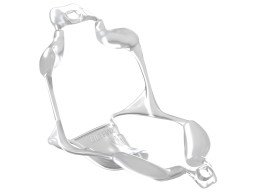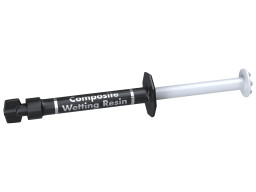Free Standard Shipping on All Orders $285+
Instructions for Use (IFU)
Safety Data Sheets (SDS)
Product Allergens
See any common allergens this product may contain >>Price breaks are offered on most items...
This amount is an estimate based on retail price. The actual amount due (shown at the final stages of your order) may be different from what is displayed here.
Return Policy
Items returned within 30 days of purchase with a return authorization number on the outside and inside of the return box will be credited 100%. Product returned between 31 and 60 days from purchase date is subject to a 20% restocking fee. Ultradent will not accept returns after 60 days. Errors in shipment must be reported within 14 days of invoice date. All return authorization numbers become invalid 90 days after date of issue. A return authorization number must accompany all returns to receive proper credit. Please contact Customer Service at 800.552.5512 for assistance.
Limited Warranty
Opalescence Boost in-office power whitener is a chemically activated gel that offers brighter, whiter teeth after about an hour in the dental chair.1 The powerful 40% hydrogen peroxide gel is chemically activated, meaning no LED teeth whitening lights are necessary with Opalescence teeth whitening, as lights do not affect the whitening results.2 Using the unique double-syringe configuration, the clinician activates the 40% hydrogen peroxide formula just prior to application, ensuring every dose of Opalescence Boost whitening is fresh and effective.
- Chemically activated, so no light is needed
- Powerful 40% hydrogen peroxide gel
- Opalescence teeth whitening gel contains PF (potassium nitrate and fluoride)
- Fresh chemical for each application
- Precise delivery
- Easy to see for complete removal
- Two to three 20-minute applications
- Thicker formula prevents the gel from running
- No refrigeration required prior to mixing
- Use with Black Mini™ Tip
- Vegan—no animal products
- Certified gluten free
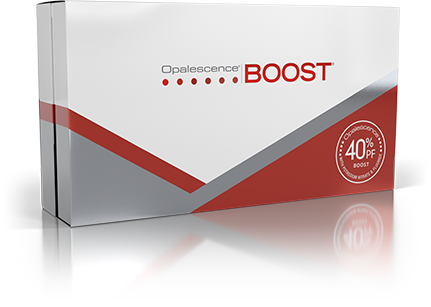

Professional Teeth Whitening With Immediate Results
Award-winning Opalescence Boost in-office teeth whitening gel is the best way to whiten teeth quickly. With just two or three 20-minute treatments its powerful 40% hydrogen peroxide formula provides noticeable results in as little as one hour.1 It is perfect for patients who want to get whiter teeth fast, who have particularly difficult stains to remove, or who have an important event around the corner that requires a bright, white smile.
Trust the experts. With over 30 years of experience, more than 50 teeth whitening awards earned, and over 100 million smiles brightened, Opalescence teeth whitening is the #1 professional teeth whitening brand on the planet.



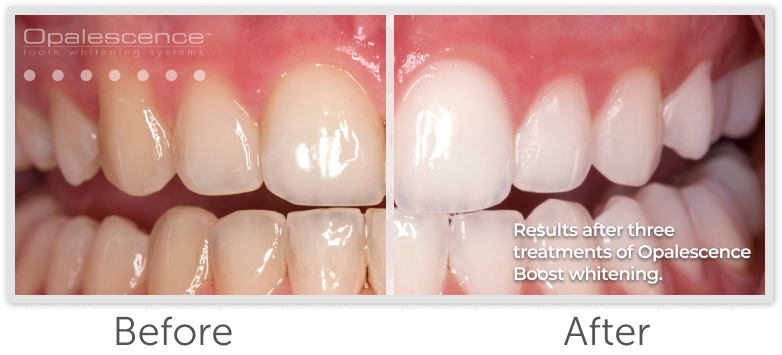
The Best Way to Whiten Teeth Fast
Some in-office whitening procedures rely on lights or lasers to “activate” the chemical whitening agent. However, Opalescence Boost in-office whitening relies solely on chemical activation. Studies have confirmed that the whitening agent is effective without any lasers.3, 4
Opalescence Boost teeth whitening gel’s innovative double-syringe mixing configuration ensures fresh teeth whitening gel for each application. Because the gel is chemically activated, no refrigeration is required prior to mixing.
After it is mixed, Opalescence Boost teeth whitening gel is conveniently applied using a Black Mini™ tip. Its thick viscosity formula prevents the gel from running, and its noticeable red color makes it easily visible to aid in precise placement and complete removal. Opalescence Boost whitening gel is also formulated with at least 20% water content, which helps prevent dehydration—maximizing patient comfort and satisfaction.
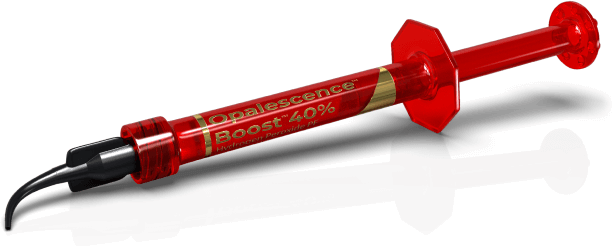
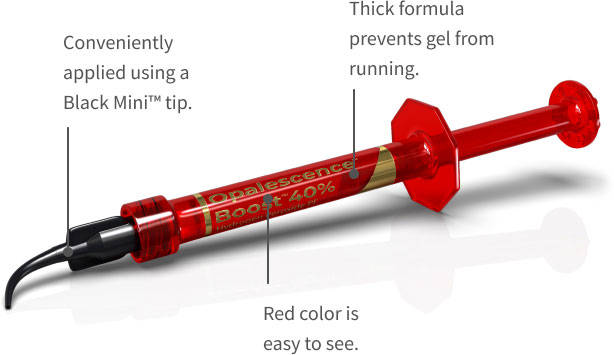
Create an At-Home Teeth Whitening Kit for Your Patients
While each Opalescence teeth whitening kit is effective as a stand-alone teeth whitening treatment, many patients benefit from using a combination of products to meet their needs. Because each Opalescence teeth whitening product works in combination with the others, it is easy to create a customized teeth whitening kit for any patient to take home. For example, Opalescence Go teeth whitening trays are a great way to follow-up an Opalescence™ Boost™ in-office whitening treatment and go perfectly with the daily use of Opalescence™ Whitening Toothpaste. A 1 oz. tube of Opalescence Whitening Toothpaste is included with each Opalescence Go whitening patient kit.
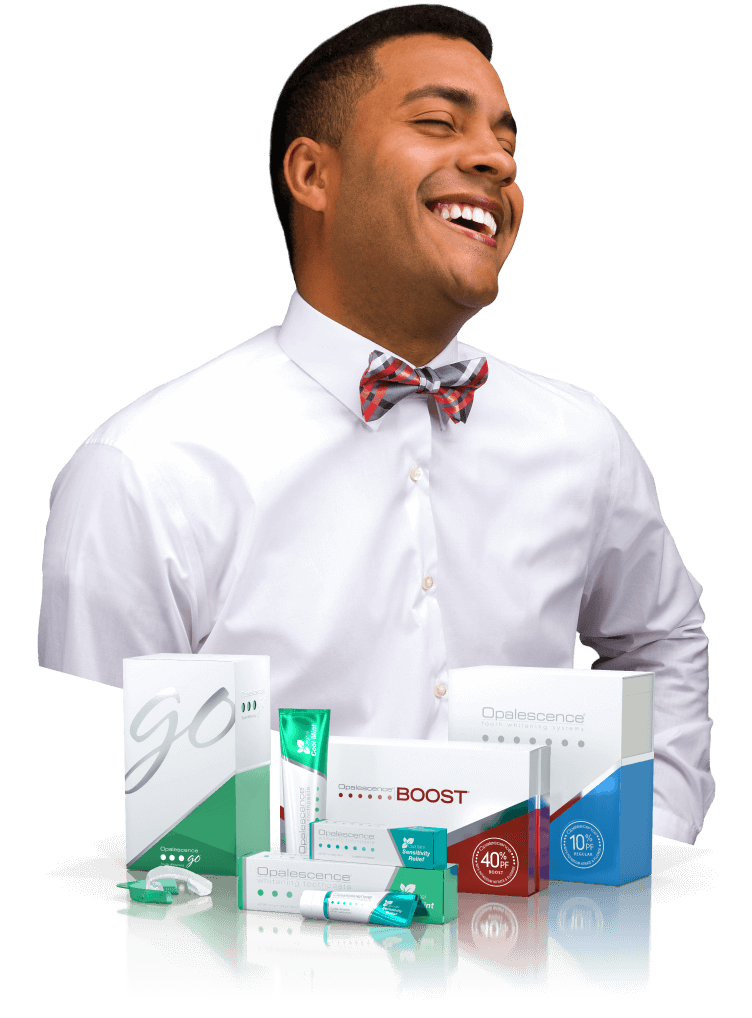

























Technical Details
Formulated with High Water Content
Many whitening products on the market dehydrate teeth, resulting in uncomfortable sensitivity for patients. Opalescence Boost teeth whitening gel is made up of at least 20% water content which prevents dehydration. Opalescence gel is effective in helping reduce shade relapse as compared to competitor tooth whitening products5, 6
Contains PF
No Refrigeration Required Prior To Mixing
Vegan and Certified Gluten Free
Opalescence Boost whitening gel is vegan, meaning no animal products are used. It is also certified gluten free by the Gluten Intolerance Group of North America (GFCO)—an independent, third-party certification program for gluten-free products. This means it fits in with the lifestyles and beliefs of patients from diverse backgrounds.
Made in the USA from Globally Sourced Materials
Opalescence teeth whitening gels, trays, syringes, and toothpastes are manufactured at Ultradent’s facility in Utah from globally sourced materials. By purchasing products manufactured in the USA, you are supporting our nation’s economy and helping to provide jobs to hundreds of Americans who take pride in what they do.
Clinicals
Before and After Opalescence Boost Whitening

Before Opalescence Boost whitening.

After three applications, each lasting 20 minutes, over one session.

Before Opalescence Boost whitening.

After six applications, each lasting 15 minutes, over two sessions.

Before Opalescence Boost whitening.

After six applications, each lasting 15 minutes, over two sessions.
Procedures
Opalescence Boost Whitening Procedure
See Instructions for Use for complete instructions, warnings, and precautions.
Step 1

Confirm that the syringes are securely attached. Depress the small clear plunger (A) into the middle small clear syringe (B) to rupture the internal membrane and combine whitening agent and activator. Press the plunger of the red syringe into the larger clear syringe.
Step 2

Press the contents of the clear syringe back into the red syringe. Thoroughly and rapidly mix the contents by pushing back and forth continually a minimum of 50 times (25 times each side).
Step 3

Press all mixed gel into RED syringe and separate the two syringes.
Step 4

Attach the Black Mini™ tip onto the red syringe. Verify flow on a cotton gauze or mixing pad prior to applying it intraorally. If resistance is met, replace the tip and recheck the flow.
Step 5

Place Ultradent IsoBlock™ bite block and self-supporting plastic cheek retractors. Completely rinse and air dry teeth and gingiva.
Step 6

Securely attach recommended tip to an OpalDam™ resin barrier syringe and check flow. Express a continuous bead along the gingival margin, overlapping approximately 0.5 mm onto the enamel. Begin and finish the bead one tooth beyond the most distal tooth that is being whitened. Express the resin through any open embrasures.
Step 7

Light cure the OpalDam resin barrier for 20 seconds per arch using a scanning motion. Check the resin cure with an instrument, using caution to not disrupt the seal.
Step 8

Apply a 0.5–1.0 mm thick layer of the gel to the labial surface of the tooth. Allow the gel to remain on the teeth for 20 minutes per application.
Step 9

Suction gel from teeth using the Ultradent™ Luer Vacuum Adapter and SST™ tip or a surgical suction tip. To avoid gel splatter, do not use water while suctioning gel. When no gel is visible, lightly rinse and air dry. Use caution not to dislodge the isolation barrier or rubber dam seal.
Step 10

After the final application is complete and all visible gel is removed, thoroughly rinse the teeth with an air/water spray and high volume suction.
Step 11

Gently slide the tip of a dental instrument beneath the OpalDam resin barrier and lift it off. Check for and remove any interproximal remnants.
Step 12

Evaluate the shade change. If additional whitening is desired and no sensitivity is noted, reschedule patient in 3–5 days for repeat treatment or dispense take-home whitening treatment.
Testimonials
“We love brightening smiles with Opalescence Boost. It does a better job than the other in-office whitening systems we’ve used. It’s easy to use, and patients rave about the results.”
Julia Ellis, Office Manager – Hopewell, VA
Frequently Asked Questions
-
How does teeth whitening work?
Opalescence whitening gels contain a powerful whitening ingredient, either carbamide peroxide or hydrogen peroxide. Peroxide gels break down into water, oxygen, and reactive oxygen molecules. These reactive oxygen molecules oxidize the bonds of discolored stain molecules. By changing the stained molecules, the tooth appearance becomes lighter.7
Reactive oxygen molecules permeate the entire tooth, so there is no need for the whitening agent to be in contact with every surface of the tooth for the entire tooth to be whitened.7
-
Will teeth whitening affect bond strength?
We recommend abstaining from any whitening treatments for 7–10 days before a bonding procedure.10, 8, 9 -
How long do teeth whitening results last?
Tooth whitening results can last a year or more.11, 12 Teeth whitening results are very stable, but depending on the patient’s nutrition and lifestyle habits, the procedure may need to be redone periodically. Due to the safety of the teeth whitening agents, this should not concern the dentist or patient. -
Will teeth whitening cause sensitivity?
Tooth sensitivity can occur as a result of whitening. If sensitivity occurs, it is transient and disappears after the completion of whitening treatments. If desensitizing treatments are desired, we recommend the use of UltraEZ™ desensitizing gel or Enamelast™ fluoride varnish. Opalescence™ Whitening Toothpaste Sensitivity Formula can also be used to help to prevent or lessen sensitivity if it occurs.
Research & Studies
Carbamide peroxide whitening of nonvital single discolored teeth: case reports.
Caughman WF, Frazier KB, Haywood VB. Carbamide peroxide whitening of nonvital single discolored teeth: case reports.
http://www.ncbi.nlm.nih.gov/pubmed/10356567 – Caughman WF, Frazier KB, Haywood VB.External bleaching therapy with activation by heat, light or laser—a systematic review.
Buchalla W, Attin T. External bleaching therapy with activation by heat, light or laser—a systematic review. Dent Mater. 2007;23(5):586-96.
http://www.ncbi.nlm.nih.gov/pubmed/16820199 – Buchalla W, Attin T.In-office vital tooth bleaching—what do lights add?
Hein DK, Ploeger BJ, Hartup JK, Wagstaff RS, Palmer TM, Hansen LD. In-office vital tooth bleaching—what do lights add? Compend Contin Educ Dent. 2003;24(4A):340-52.
http://www.ncbi.nlm.nih.gov/pubmed/12793211 – Hein DK, Ploeger BJ, Hartup JK, Wagstaff RS, Palmer TM, Hansen LD.The effect of tooth bleaching on substance P expression in human dental pulp.
Caviedes-Bucheli J, Ariza-García G, Restrepo-Méndez S, Ríos-Osorio N, Lombana N, Muñoz HR. The effect of tooth bleaching on substance P expression in human dental pulp. J Endod. 2008;34(12):1462-5.
http://www.ncbi.nlm.nih.gov/pubmed/19026874 – Caviedes-Bucheli J, Ariza-García G, Restrepo-Méndez S, Ríos-Osorio N, Lombana N, Muñoz HR.Clinical evaluation of chemical and light-activated tooth whitening systems.
Kugel G, Papathanasiou A, Williams AJ 3rd, Anderson C, Ferreira S. Clinical evaluation of chemical and light-activated tooth whitening systems. Compend Contin Educ. 2006;27(1)54-62.
http://www.ncbi.nlm.nih.gov/pubmed/16454016 – Kugel G, Papathanasiou A, Williams AJ 3rd, Anderson C, Ferreira S.In vitro efficacy and risk for adverse effects of light-assisted tooth bleaching.
Bruzell EM, Johnsen B, Aalerud TN, Dahl JE, Christensen T. In vitro efficacy and risk for adverse effects of light-assisted tooth bleaching. Photochem Photobiol Sci. 2009;8(3):377-85.
http://www.ncbi.nlm.nih.gov/pubmed/19255679 – Bruzell EM, Johnsen B, Aalerud TN, Dahl JE, Christensen T. Photochem.New bleaching considerations compared with at-home bleaching.
Haywood, V. New bleaching considerations compared with at-home bleaching. J Esthet Restor Dent. 2003;15(3):184-7.
https://pubmed.ncbi.nlm.nih.gov/12859116/ – Haywood, V.Colorimetric assessment of laser and home bleaching techniques.
Jones AH, Diaz-Arnold AM, Vargas MA, Cobb DS. Colorimetric assessment of laser and home bleaching techniques. J Esthet Dent. 1999;11(2):87-94.
http://www.ncbi.nlm.nih.gov/pubmed/10530271 – Jones AH, Diaz-Arnold AM, Vargas MA, Cobb DS.



